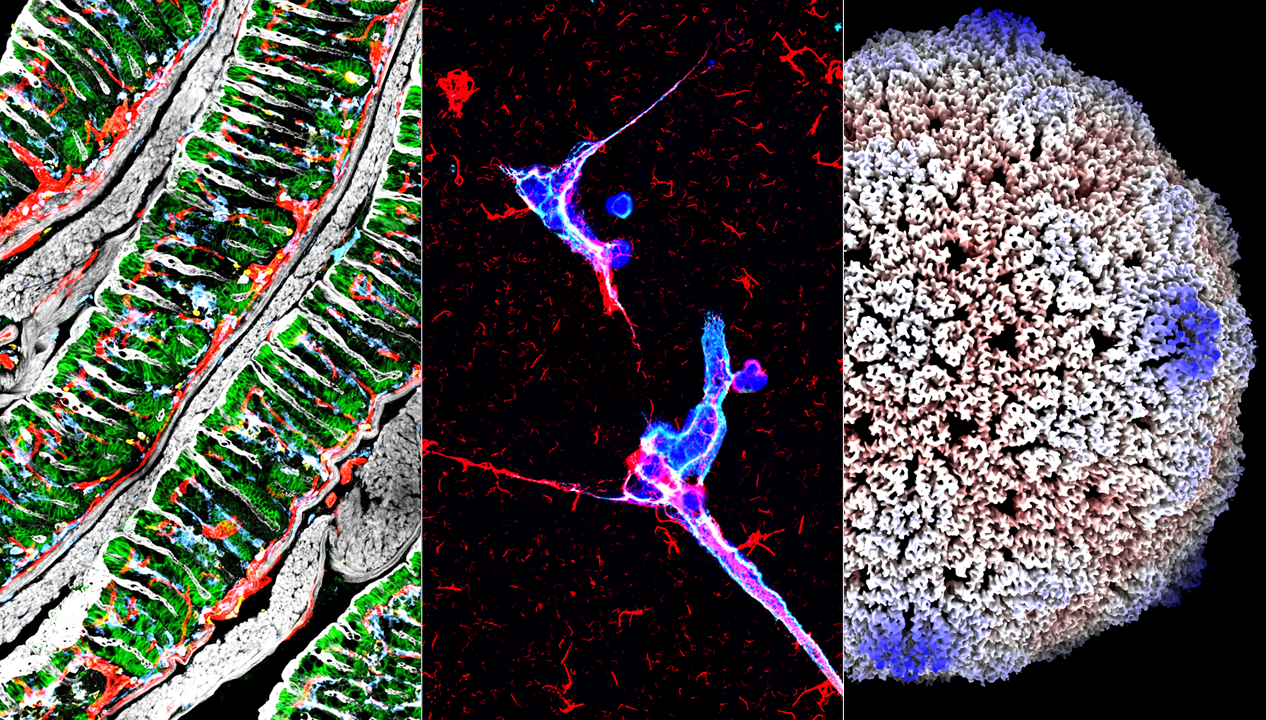
Image credit: Ben Gregory, EPLS intern, "Immune cells of the Mouse Colon" (left); Andy Stewart, Clatworthy Lab, neutrophils and uropathogenic e. coli (middle); Yorgo Modis, PI, "Cryo-EM reconstruction of a viral capsid particle formed from an endogenous retroviral capsid protein" (right)
Our work aims to find better, more specific and effective treatments for patients.
Immune-mediated diseases
Our work in immune-mediated diseases is particularly focused on inflammatory bowel disease, ANCA-associated vasculitis and SLE.
- We profile genetic contributions using genome-wide association studies and develop novel statistical approaches to identify new risk loci for diseases.
- We use high dimensional cell phenotyping within the NIHR Cambridge BRC Cell Phenotyping Hub, as well as metabolomics and genomics, including single cell and nuclear RNA sequencing, coupled with antigen receptor sequencing, to understand cell type-specific molecular contributions to disease pathogenesis and stratification.
- We have optimised human tissue processing pipelines and advanced imaging capability, including spatial transcriptomics, ensuring we can study immune responses beyond the blood within diseased organs. Our researchers use this information to identify biomarkers that can help predict disease course and guide treatment stratification and to discover new treatment targets.
- We use in vitro assays with cell lines and organoids and other more complex non-human models to validate our findings.
- We work with research-active NHS clinicians to test new treatment strategies within Experimental Medicine Studies and deliver blood and tissue analyses that provide critical insights into drug mechanism of action and limitations.
Infectious diseases
In infectious disease research, our scientists study both the pathogen (particularly SARS-CoV-2, HIV, CMV, mycobacteria and salmonella) and the host immune responses to these microbes and to vaccines.
- Our work was critical to the local and national response to the COVID-19 pandemic, identifying correlates of protection, monitoring the evolution of SARS-CoV-2 within patients, and finding diagnostic tests for long COVID. Read our story
- We work in HIV to understand the viral cell reservoir, how host cells respond to HIV infection, mechanisms underpinning drug resistance, all of which inform the design of strategies to cure HIV.
- Some viruses move from other species into humans, and we are defining molecular details of what allows them to emerge in humans (or hinders them from doing so).
- We have developed the zebrafish as model to study immunity to tuberculosis, using forward and reverse genetics to understand the basis of host resistance and susceptibility to TB.
- We study the microbiome, and how interactions with gut microbes and microbial metabolites affect resistance to infection, local and systemic immune responses.
- Some viruses have incorporated their genetic material into the human genome, and our scientists are working to understand how the host ensures these foreign sequences are epigenetically silenced defending the genome from retroelement attack.

